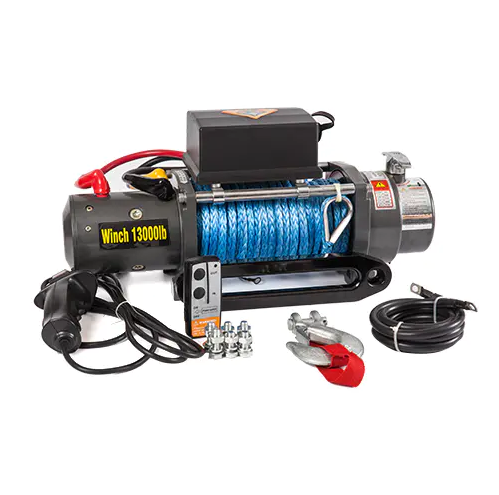Step-by-step Guide On How To Use A Portable Electric Winch Before utilizing a winch, prioritizing safety by adhering t...
Before utilizing a portable electric winch, ensure it is firmly affixed to a stable surface. Connect the winch to a powe...
Off-roading in a 4x4 vehicle can be an exhilarating adventure, but it also comes with its share of challenges and obstac...
Winching is a valuable technique used in off-road situations, recovery operations, and various other scenarios where a vehicle needs to be pulled or moved using a winch. While winching can be a highly effective method, it also carries inherent risks if not performed safely and correctly. In this guide, I will provide you with essential tips to winch safely. recovery operations, and various other scenarios where a vehicle needs to be pulled or moved using a winch. While winching can be a highly effective method, it also carries inherent risks if not performed safely and correctly. In this guide, I will provide you with essential tips to winch safely.

Before starting any winching operation, thoroughly inspect all winching equipment, including the winch itself, cables or ropes, hooks, and other accessories. Ensure that everything is in good working condition and free from damage or wear. Regularly maintain and lubricate your winch according to the manufacturer's recommendations.
Select a winch that matches the weight and requirements of your vehicle. Consider factors such as the Gross Vehicle Weight Rating (GVWR) and the terrain in which you will be operating. Use appropriate accessories, such as tree trunk protectors, snatch blocks, and D-shackles, to enhance the safety and effectiveness of your winching operations.
Check out our off road electric winch too.
Familiarize yourself with the user manual provided by the winch manufacturer. It contains crucial information regarding the safe and correct operation of your specific winch model. Pay attention to the recommended capacity, proper cable or rope usage, and any specific instructions or warnings.
Always wear appropriate protective gear, including gloves, eye protection, and sturdy footwear when winching. This will help protect you from potential hazards such as wire splinters, cable snapback, or flying debris.
Before commencing a winching operation, evaluate the situation carefully. Identify potential hazards, obstacles, or unstable ground conditions that could affect the operation. Plan the winching procedure accordingly, considering the position of the anchor point, the direction of the pull, and any potential risks to bystanders.
Select a solid anchor point that can withstand the force exerted during the winching process. This can include trees, large rocks, or other stationary objects. Ensure that the anchor point is secure and will not move or give way during the operation. Use a tree trunk protector or a suitable anchor strap to prevent damage to trees or other anchor points.
Properly rigging the winch is crucial for safe and efficient winching. Attach the winch cable or rope securely to the anchor point using an appropriate method, such as a bowline knot or a shackle. Avoid using damaged or worn cables or ropes, and ensure that they are properly spooled onto the winch drum without any twists or tangles.
A snatch block can increase the pulling power of your winch and change the direction of the pull. When using a snatch block, attach it to a secure anchor point and run the cable or rope through it. This will reduce the load on your car winch and provide more control over the pulling direction.
Maintain consistent tension on the cable or rope during the winching operation. Avoid overloading the winch or exceeding its rated capacity. If necessary, use ground anchors or winch extensions to increase the length and capacity of the cable or rope.
Establish clear communication signals with other team members involved in the winching operation. Maintain constant communication and visual contact throughout the process. Stay focused and alert, monitoring the winch, anchor point, and the surroundings for any signs of strain, instability, or potential hazards.
Never stand directly in front of or behind the winch cable or rope. In the event of a cable
Avoid sudden or jerky movements when operating the winch. Apply a controlled and gradual pulling force, allowing the winch to work steadily. Sudden releases or jerking motions can lead to equipment failure or loss of control.
Regularly inspect the winch cable or rope for signs of damage, such as fraying, kinks, or broken strands. If any damage is detected, replace the cable or rope immediately to prevent a potential failure during winching.
Become familiar with proper winch operation techniques, including the use of winch controllers, understanding winch controls, and the proper positioning of your vehicle during the operation. Practice these techniques in a controlled environment before engaging in actual recovery or winching situations.
If you are unsure about the winching operation or face challenging or hazardous conditions, it is advisable to seek professional assistance. Trained recovery experts have the experience and specialized equipment to handle complex recovery situations safely.
Remember, safety should always be the top priority when performing winching operations. By following these essential tips and exercising caution, you can minimize risks and ensure a successful and safe winching experience.
If you want to know more information about Off-Road Electric Winches, please contact us. We will provide professional answers

As a famous wholesale high power electric winches Manufacturers, We have a strong desire that we can double-win with our customer.
Add:Changtan Industrial Zone, Zhang shui Town, Haishu District, Ningbo, China
Tel:+86-18367483862
WeChat:+86-18367483862
WhatsApp:+86-151 6815 7361
E-mail:sales@hcwinches.com
E-mail:sales2@hcwinches.com
TOP
